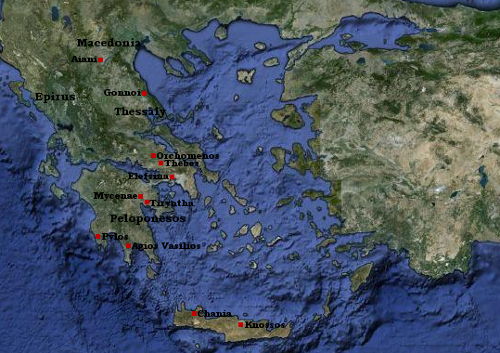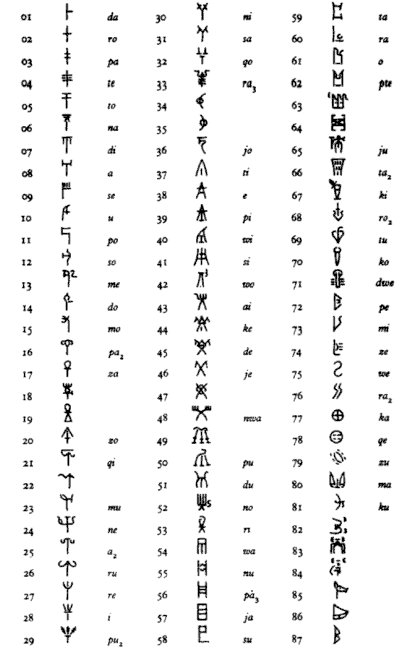Mycenaean Greek and Linear B
Linear B is the first attested writing system of the Greeks. It was used between the 17thIf genuine, the Kafkania pebble is the oldest Linear B document attested. (or 15th century) and 12th century BC and was successor of the Minoan Linear A, a writing system that has not yet been deciphered. Most records have been found on clay tablets in Knosos (Crete), Pylos and Mycenae (Peloponesos) but evidence of its usage reaches as north as Aiani (Macedonia)See Karamitrou-Mentesidi 2008.
The History of the decipherment of Linear B

Yet this discovery gave him the impetus to continue his quest. The seals were said to originate from the island of Crete, and in particular Knossos, where legend told of the palace of King Minos, the centre of an empire that dominated the Aegean. Sir Arthur set out for Crete and began excavating in Ancient sites around the Aegean Sea. Having uncovered treasures at Mycenae on mainland Greece, Sir Arthur Evans went in search of inscribed tablets. The first Linear B tablets were discovered on the island of Crete, the centre of the Minoan empire.
March 1900. The results were as spectacular as they were rapid. He uncovered the remains of a luxurious palace, riddled with an intricate network of passageways and adorned with frescoes of young men leaping over ferocious bulls. Evans speculated that the sport of bull jumping was somehow linked to the legend of the Minotaur, the bull-headed monster that fed on youths, and he suggested that the complexity of the palace passages had inspired the story of the Minotaur's labyrinth.On March 31, Sir Arthur began unearthing the treasure that he had desired most of all. Initially he discovered a single clay tablet with an inscription, then a few days later a wooden chest full of them, and then stockpiles of written material beyond all his expectations. All these clay tablets had originally been allowed to dry in the sun, rather than being fired, so that they could be recycled simply by adding water. Over the centuries, rain should have dissolved the tablets, and they should have been lost forever. However, it appeared that the palace at Knossos had been destroyed by fire, baking the tablets and helping to preserve them for three thousand years. Their condition was so good that it was still possible to discern the fingerprints of the scribes. The tablets fell into three categories. The first set of tablets, dating from 2000 to 1650 b.c., consisted merely of drawings, probably semagrams, apparently related to the symbols on the seals that Sir Arthur Evans had bought from dealers in Athens. The second set of tablets, dating from 1750 to 1450 b.c., were inscribed with characters that consisted of simple lines, and hence the script was dubbed Linear A. The third set of tablets, dating from 1450 to 1375 b.c., bore a script which seemed to be a refinement of Linear A, and hence called Linear B. Because most of the tablets were Linear B, and because it was the most recent script, Sir Arthur and other archaeologists believed that Linear B gave them their best chance of decipherment. Many of the tablets seemed to contain inventories. With so many columns of numerical characters it was relatively easy to work out the counting system, but the phonetic characters were far more puzzling. They looked like a meaningless collection of arbitrary doodles. The historian David Kahn described some of the individual characters as a Gothic arch enclosing a vertical line, a ladder, a heart with a tem running through it, a bent trident with a barb, a three-legged dinosaur looking behind him, an A with an extra horizontal bar running through it, a backward S, a tall beer glass, half full, with a bow tied on its rim; dozens look like nothing at all.' Only two useful facts could be established about Linear B. First, the direction of the writing was clearly from left to right, as any gap at the end of a line was generally on the right. Second, there were 90 distinct characters, which implied that the writing was almost certainly syllabic. Purely alphabetic scripts tend to have between 20 and 40 characters (Russian, for example, has 36 signs, and Arabic has 28). At the other extreme, scripts that rely on semagrams tend to have hundreds or even thousands of signs (Chinese has over 5,000). Syllabic scripts occupy the middle ground, with between 50 and 100 syllabic characters. Beyond these two facts, Linear B was an unfathomable mystery.
The fundamental problem was that nobody could be sure what language Linear B was written in. Initially, there was speculation that Linear B was a written form of Greek, because seven of the characters bore a close resemblance to characters in the classical Cypriot script, which was known to be a form of Greek script used between 600 and 200 b.c. But doubts began to appear. The most common final consonant in Greek is s, and consequently the commonest final character in the Cypriot script is f1, which represents the syllable se- because the characters are syllabic, a lone consonant has to be represented by a consonant-vowel combination, the vowel remaining silent. This same character also appears in Linear B, but it is rarely found at the end of a word, indicating that Linear B could not be Greek. The general consensus was that Linear B, the older script, represented an unknown and extinct language. When this language died out, the writing remained and evolved over the centuries into the Cypriot script, which was used to write Greek. Therefore, the two scripts looked similar but expressed totally different languages.
Sir Arthur Evans was a great supporter of the theory that Linear B was not a written form of Greek, and instead believed that it represented a native Cretan language. He was convinced that there was strong archaeological evidence to back up his argument. For example, his discoveries on the island of Crete suggested that the empire of King Minos, known as the Minoan empire, was far more advanced than the on the mainland. The Minoan Empire was not a dominion of the Mycenaean empire, but rather a rival, possibly even the dominant power. The myth of the Minotaur supported this position. The legend described how King Minos would demand that the Athenians send him groups of youths and maidens to be sacrificed to the Minotaur. In short, Evans concluded that the Minoans were so successful that they would have retained their native language, rather than adopting Greek, the language of their rivals. Although it became widely accepted that the Minoans spoke their own non-Greek language (and Linear B represented this language), there were one or two heretics who argued that the Minoans spoke and wrote Greek. Sir Arthur did not take such dissent lightly, and used his influence to punish those who disagreed with him. When A.J.B. Wace, Professor of Archaeology at the University of Cambridge, spoke in favour of the theory that Linear B represented Greek, Sir Arthur excluded him from all excavations, and forced him to retire from the British School in Athens. Then, in 1941, at the age of ninety, Sir Arthur died. He did not live to witness the decipherment of Linear B, or to read for himself the meanings of the texts he had discovered. Indeed, at this point, there seemed little prospect of ever deciphering Linear B.
After the death of Sir Arthur Evans the Linear B archive of tablets and his own archaeological notes were available only to a restricted circle of archaeologists, namely those who supported his theory that Linear B represented a distinct Minoan language. However, in the mid-1940s, Alice Kober, a classicist at Brooklyn College, managed to gain access to the material, and began a meticulous and impartial analysis of the script. To those who knew her only in passing, Kober seemed quite ordinary - a dowdy professor, neither charming nor charismatic, with a rather matter-of-fact approach to life. However, her passion for her research was immeasurable. 'She worked with a subdued intensity,' recalls Eva Brann, a former student who went on to become an archaeologist at Yale University. 'She once told me that the only way to know when you have done something truly great is when your spine tingles.' In order to crack Linear B, Kober realized that she would have to abandon all preconceptions. She focused on nothing else but the structure of the overall script and the construction of individual words. In particular, she noticed that certain words formed triplets, inasmuch as they seemed to be the same word reappearing in three slightly varied forms. Within a word triplet, the stems were identical but there were three possible endings. She concluded that Linear B represented a highly inflective language, meaning that word endings are changed in order to reflect gender, tense, case and so on.
John Chadwick
Just a few months before she died, Alice Kober received a letter from Michael Ventris, an English architect who had been fascinated by Linear B ever since he was a child. Ventris was born on July 12, 1922, the son of an English Army officer and his half-Polish wife. His mother was largely responsible for encouraging an interest in archaeology, regularly escorting him to the British Museum where he could marvel at the wonders of the ancient world. Michael was a bright child, with an especially prodigious talent for languages. When he began his schooling he went to Gstaad in Switzerland, and became fluent in French and German. Then, at the age of six, he taught himself Polish.
Like Jean-Francois Champollion, Ventris developed an early love of ancient scripts. At the age of seven he studied a book on Egyptian hieroglyphics, an impressive achievement for one so young, particularly as the book was written in German. This interest in the writings of ancient civilizations continued throughout his childhood. In 1936, at the age of fourteen, it was further ignited when he attended a lecture given by Sir Arthur Evans, the discoverer of Linear B. The young Ventris learned about the Minoan civilization and the mystery of Linear B, and promised himself that he would decipher the script.
His own belief was that Linear B was related to Etruscan, a reasonable standpoint because there was evidence that the Etruscans had come from the Aegean before settling in Italy. After years of intense study, he noticed something peculiar-something that seemed to suggest an exception to the rule that all Linear B signs are syllables. He also that noticed three words that appeared over and over again on and based on nothing more than intuition, he conjectured that these words might be the names of important towns. The only significant name that fitted the bill was Amnisos, an important harbor town. If he was right, then the second and third signs, 73 and 30, would represent -mi-and -ni-. These two syllables both contain the same vowel, i, so numbers 73 and 30 ought to appear in the same vowel column of the grid. They do. The final sign, 12, would represent -so-, leaving nothing to represent the final s. Ventris decided to ignore the problem of the missing final s for the time being, and proceeded with the following working translation:
Town 1 =  = a-mi-ni-so = Amnisos
= a-mi-ni-so = Amnisos
This was only a guess, but the repercussions on Ventris's grid were enormous. For example, the sign 12, which seems to represent -so-, is in the second vowel column and the seventh consonant row. Hence, if his guess was correct, then all the other syllabic signs in the second vowel column would contain the vowel o, and all the other syllabic signs in the seventh consonant row would contain the consonant s.
Town 2 =  = ?o-?o-so = ?
= ?o-?o-so = ?
Could this be Knossos? The signs could represent ko-no-so. Once again, Ventris was happy to ignore the problem of the missing final s, at least for the time being. He was pleased to note that sign 52, which supposedly represented -no-, was in the same consonant row as sign 30, which supposedly represented -ni- in Amnisos. This was reassuring, because if they contain the same consonant, n, then they should indeed be in the same consonant row. Using the syllabic information from Knossos and Amnisos, he inserted the following letters into the third town:
Town 3 =  = ??-?i-SO
= ??-?i-SO
The only name that seemed to fit was Tulissos (tu-li-so), an important town in central Crete. Once again the final s was missing, and once again Ventris ignored the problem. He had now tentatively identified three place names and the sound values of eight different signs:
Town 1 =  = a-mi-ni-so = Amnisos
= a-mi-ni-so = Amnisos
Town 2 =  = ko-no-so = Knossos
= ko-no-so = Knossos
Town 3 =  = tu-li-so = Tulissoss
= tu-li-so = Tulissoss
The repercussions of identifying eight signs were enormous. Ventris could infer consonant or vowel values to many of the other signs in the grid, if they were in the same row or column. The result was that many signs revealed part of their syllabic meaning, and a few could be fully identified. Deducing the syllabic values of these two signs, 05 and 31, was particularly important because it allowed Ventris to read two complete words, 05-12 and 05-31, which often appeared at the bottom of inventories. Because of this, experts had suspected that they meant 'total.' Ventris now read them as toso and tosa, uncannily similar to the archaic Greek tossos and tossa, masculine and feminine forms meaning 'so much.' Now, he was uncovering words which were clear evidence in favour of Greek as the language of Linear B. Ventris soon deciphered a handful of other words, which also bore a resemblance to Greek, but he was still not absolutely convinced that Linear B was a Greek script.
While Ventris was giving an interview to BBC radio, one of the listeners was John Chadwick, a Cambridge researcher who had been interested in the decipherment of Linear B since the 1930s. When he heard the radio interview, he was completely taken aback by Ventris's apparently preposterous claim. Chadwick, along with the majority of scholars listening to the broadcast, dismissed the claim as the work of an amateur - which indeed it was. However, as a lecturer in Greek, Chadwick realized that he would be pelted with questions regarding Ventris's claim, and to prepare for the barrage he decided to investigate Ventris's argument in detail. He obtained copies of Ventris's Work Notes, and examined them, fully expecting them to be full of holes. However, within a few days the skeptical scholar became one of the first supporters of Ventris's Greek theory of Linear B. Chadwick soon came to admire the young architect. Ventris lacked one particular expertise, namely a thorough knowledge of archaic Greek. Ventris's only formal education in Greek was as a boy at Stowe School, so he could not fully exploit his breakthrough. For example, he was unable to explain some of the deciphered words because they were not part of his Greek vocabulary. Chadwick's speciality was Greek philology, the study of the historical evolution of the Greek language, and he was therefore well equipped to show that these problematic words fitted in with theories of the most ancient forms of Greek.Together, Chadwick and Ventris formed a perfect partnership. With Ventris's deciphering skills and Chadwick's expertise in Greek, the duo went on to convince the rest of the world that Linear B is indeed Greek. The rate of translation accelerated as each day passed. In 1953, confident of their analysis, they wrote up their work in a paper, modestly entitled 'Evidence for Greek Dialect in the Mycenaean Archives,' which was published in The Journal of Hellenic Studies.
On June 24, 1953, Ventris gave a public lecture outlining the decipherment of Linear B. The following day it was reported in The Times, next to a comment on the recent conquest of Everest. This led to Ventris and Chadwick's achievement being known as the 'Everest of Greek Archaeology.' The following year, the men decided to write an authoritative three-volume account of their work which would include a description of the decipherment, a detailed analysis of three hundred tablets, a dictionary of 630 Mycenaean words and a list of sound values for nearly all Linear B signs. Documents in Mycenaean Greek was completed in the summer of 1955, and was ready for publication in the autumn of 1956. However, a few weeks before printing, on September 6, 1956, Michael Ventris was killed. While driving home late at night on the Great North Road near Hatfield, his car collided with a truck.
The Linear B symbols

Gallery
Samples in Mycenaean Greek with translationIn the above examples, syllables in -ra-/-re-/-ru- are transliterated as -la-/-le-/-lu-. There's no distinction of R and L in Linear B.
Example 1Syllabic reading
Mycenean Greek reading
Modern Greek
English Translation
Example 2
Syllabic reading
Mycenean Greek reading
Modern Greek
English Translation
Example 3
Syllabic reading
Mycenean Greek reading
Modern Greek
English Translation
Sources & further reading
Simon Singh, "The Code Book: The Science of Secrecy from Ancient Egypt to Quantum Cryptography", 1999, Anchor BooksJ.T. Hooker, "Linear B: An Introduction", 1991, Bristol Classical Press
Tags: Greek, Greece, Proto-Greek, Proto-Greeks, Linear B, Mycenaean Greek, Mycenaeans, Mycenae, Linear A, Minoans, Cretans, Pre-Greek, Helladic, Decipherment, Ventris, Kober, Chadwick, Agamemnon, Indo-Europeans in Greece











